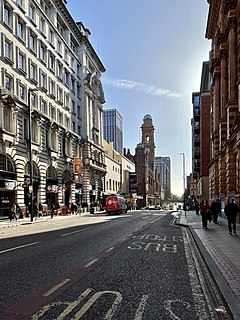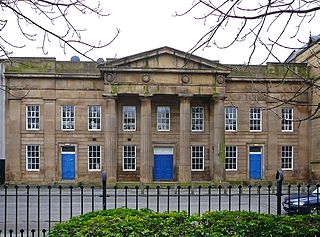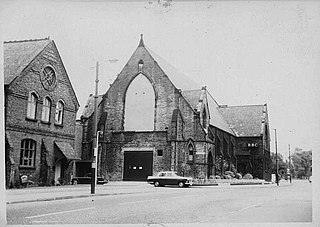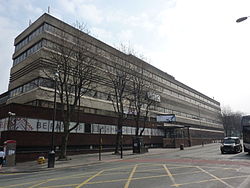
Rusholme is an area of Manchester, England, two miles south of the city centre. The population of the ward at the 2011 census was 13,643. Rusholme is bounded by Chorlton-on-Medlock to the north, Victoria Park and Longsight to the east, Fallowfield to the south and Moss Side to the west. It has a large student population, with several student halls and many students renting terraced houses, and suburban houses towards Victoria Park.

Wilmslow Road is a major road in Manchester, England, running from Parrs Wood northwards to Rusholme. There it becomes Oxford Road and the name changes again to Oxford Street when it crosses the River Medlock and reaches the city centre.

Broadcasting House is the headquarters of the BBC, in Portland Place and Langham Place, London. The first radio broadcast from the building was made on 15 March 1932, and the building was officially opened two months later, on 15 May. The main building is in Art Deco style, with a facing of Portland stone over a steel frame. It is a Grade II* listed building and includes the BBC Radio Theatre, where music and speech programmes are recorded in front of a studio audience.

Chorlton-on-Medlock is an inner city area of Manchester, England.

BBC Cymru Wales is a division of the BBC, and the national broadcaster for Wales.
The Daily Service is a short Christian service broadcast every weekday morning between 09:45 and 10:00 on BBC Radio 4's long wave and DAB frequencies. It was also broadcast on Radio 4's FM frequencies until 13 September 1991.
The BBC Philharmonic is a national British broadcasting symphony orchestra and is one of five radio orchestras maintained by the British Broadcasting Corporation. The Philharmonic is a department of the BBC North Group division based at MediaCityUK, Salford. The orchestra's primary concert venue is the Bridgewater Hall, Manchester.

Mancunian Films was a British film production company first organised in 1934. From 1947 it was based in Rusholme, a suburb of Manchester, and produced a number of comedy films, mostly aimed at audiences in the North of England.

BBC North (Group) is an operational business division of the BBC.
BBC Radio Manchester is the BBC's local radio station serving Greater Manchester.

BBC North West is the BBC English Region serving Cheshire, Greater Manchester, Lancashire, Merseyside, North Yorkshire, West Yorkshire, Derbyshire, Cumbria and the Isle of Man.

MediaCityUK is a 200-acre (81 ha) mixed-use property development on the banks of the Manchester Ship Canal in Salford, Greater Manchester, England. The project was developed by Peel Media; its principal tenants are media organisations and the Quayside MediaCityUK shopping centre. The land occupied by the development was part of the Port of Manchester and Manchester Docks.

Deansgate Square, formerly known as Owen Street, is a skyscraper cluster on the southern edge of Manchester City Centre, consisting of four towers, the tallest of which is 201 metres. The site is just south of Deansgate railway station and north of the Mancunian Way, bounded by Deansgate, Owen Street and the River Medlock.

BBC Manchester is the British Broadcasting Corporation regional headquarters for the North West, the largest BBC region in the UK. BBC Manchester is a department of the BBC North Group division. The BBC considers the Manchester department as one of its three main national bases alongside London and Bristol, and has had a presence in the city since launching the 2ZY radio station in 1922. The BBC had its first studio outside London in 1954 when the corporation leased the Dickenson Road Studios. In 1967, the decision was taken to build a purpose-built BBC building in Manchester on Oxford Road which opened in 1976.

Media in Manchester has been an integral part of Manchester's culture and economy for many generations and has been described as the only other British city to rival to London in terms of television broadcasting. Today, Manchester is the second largest centre of the creative and digital industries in Europe.

BBC Roath Lock Studios is a television production studio that houses BBC drama productions including Doctor Who, Casualty, and Pobol y Cwm. The centre topped out on 20 February 2011 and filming for such productions commenced in autumn of the same year.

Old Granada Studios is a television studio complex and events venue on Quay Street in Manchester with the facility to broadcast live and recorded television programmes. The studios were formerly the headquarters of Granada Television and later ITV Granada from 1956 to 2013. After a period of closure, five of the six studio spaces were reopened under the All Studios banner in 2018. The studios are the oldest operating purpose-built television studios in the United Kingdom pre-dating BBC Television Centre by five years.

The Television Centre, Newcastle upon Tyne, also known by the street name City Road, was home and headquarters of the ITV contractor for the North East region, Tyne Tees Television, between 1959 and 2005.

Dickenson Road Studios was a film and television studio in Rusholme, Manchester, in North-West England. It was originally set up in 1947 in a former Wesleyan Methodist Chapel by the film production company Mancunian Films, and was acquired by BBC Television in 1954. The studio was particularly noted as the venue for the first broadcasts of the popular music television show, Top of the Pops from 1964.


















